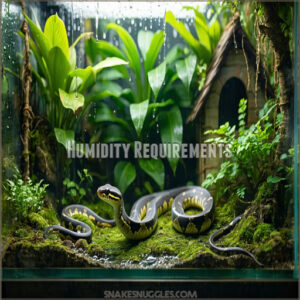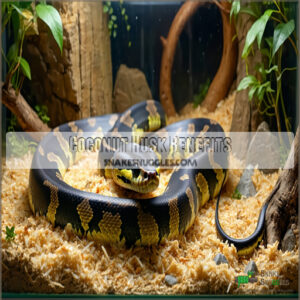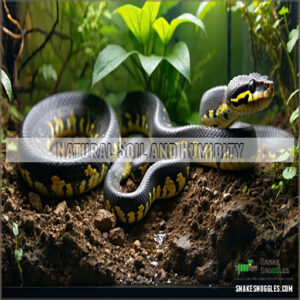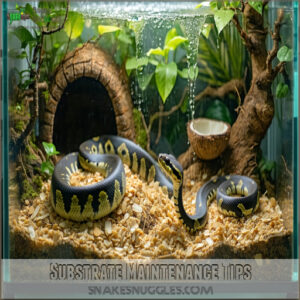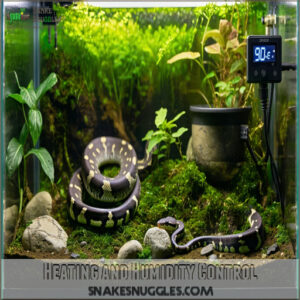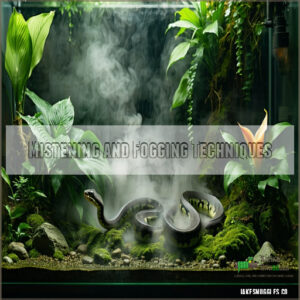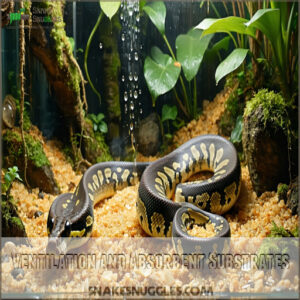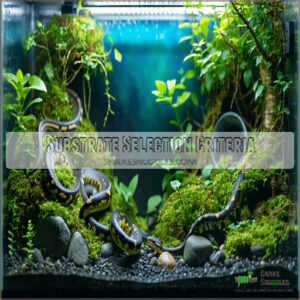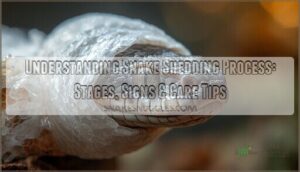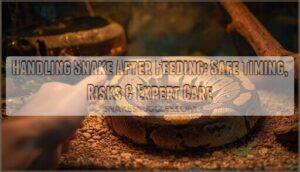This site is supported by our readers. We may earn a commission, at no cost to you, if you purchase through links.

This substrate holds water beautifully while resisting those pesky fungi that nobody wants in their snake’s home.
Layer it 2-4 inches deep to lock in that perfect 50-60% humidity level your ball python needs.
If you’re feeling adventurous, try a bioactive setup – it’s like creating a mini rainforest in your terrarium.
Just remember, keeping your snake’s humidity right is as important as serving dinner on time, and the right substrate makes all the difference in preventing those tricky shedding issues.
Table Of Contents
- Key Takeaways
- Choosing Best Substrate
- Humidity Requirements
- Substrate Characteristics
- Top 6 Substrates for Humidity
- 1. RediChip Coconut Reptile Bedding Substrate 12 Quart
- 2. ReptiChip Premium Coconut Reptile Substrate
- 3. Joshs Frogs BioBedding Tropical Substrate 10 Quarts
- 4. Zoo Med Eco Earth Loose Coconut Fiber Reptile Substrate
- 5. Zoo Med Forest Floor Bedding 2 Pack
- 6. Joshs Frogs Bulk Aspen Reptile Bedding 48 Cubic Feet
- Substrate Maintenance Tips
- Humidity Management Tips
- Substrate Selection Criteria
- Frequently Asked Questions (FAQs)
- How Often Should I Replace the Substrate for My Ball Python?
- How Do I Know Which Substrate is Best for My Ball Python?
- Are There Any Substrates That Need to Be Avoided for Ball Pythons?
- How Do I Know if My Ball Python is Comfortable in Its Substrate?
- What is the best substrate for humidity snakes?
- What substrate holds the most humidity?
- How can I keep my ball python cage humid?
- What kind of bedding should I use for ball python?
- How does substrate impact ball python behavior?
- What signs indicate a poor substrate choice?
- Conclusion
Key Takeaways
- Use coconut husk as the best substrate for ball python humidity—it holds moisture well and resists fungi, keeping the enclosure clean and healthy.
- Maintain a substrate depth of 2-4 inches to lock in the ideal humidity level needed for your ball python’s health.
- A bioactive setup can create a self-cleaning ecosystem, naturally supporting humidity and minimizing maintenance.
- Avoid substrates like aspen and pine because they dry out quickly or release harmful oils, compromising humidity and health.
Choosing Best Substrate
Picking the right substrate for your ball python isn’t just about looks—it’s about keeping them comfy and healthy.
You’ll want something that locks in humidity, supports burrowing, and doesn’t turn into a moldy mess.
Water Retention and Humidity
When discussing ball python humidity, water retention is key.
A good substrate keeps moisture levels just right for humidity maintenance. Proper ball python humidity levels are essential for their health.
Here’s what works:
- Coconut husk: Outstanding for water absorption.
- Bioactive soil: Holds moisture, creates a humid microclimate.
- Sphagnum moss: Boosts substrate moisture.
- Natural soil: Balances humidity control perfectly.
Stay damp, not swampy!
Burrowing Habits and Substrate
Ball pythons aren’t big diggers, but their burrowing habits still matter.
They enjoy exploring shallow spaces, so pick a substrate for ball pythons with good tunnel stability and proper substrate density.
| Substrate Type | Burrow Depth | Tunnel Stability |
|---|---|---|
| Bioactive Soil | 4 inches | High |
| Coconut Husk Mix | 2-3 inches | Moderate |
| Orchid Bark Blend | 2 inches | Low |
Good soil structure supports ball python humidity too!
Fungal and Parasite Risk Factors
When picking a substrate, it’s not just about burrowing—fungal risks and parasite control matter too.
Some substrates manage microbes better than others:
- Coconut husk resists fungus but watch for mites.
- Cypress mulch is antimicrobial yet tricky to clean.
- Bioactive setups handle mite risk naturally.
- Avoid aspen; it’s prone to parasites.
- Clean regularly to prevent microbe management headaches.
Considering the best ball python substrate options is important for a healthy habitat and to mitigate mite risk.
Humidity Requirements
Keeping your ball python’s humidity between 50-60% is key to keeping them healthy and comfortable.
If you don’t nail it, you might see issues like bad shedding or even respiratory problems—definitely no fun for anyone!
Maintaining 50-60% Relative Humidity
Getting the ideal ball python humidity (50-60%) means balancing water management and good air circulation.
Substrate depth matters too—go for 2-4 inches to lock in moisture.
Don’t forget temperature fluctuations also affect humidity control.
Think of your python as Goldilocks—everything’s gotta be “just right!”
Here’s a quick guide:
| Factor | Ideal Range | Tips |
|---|---|---|
| Substrate Depth | 2-4 inches | Use coconut husk or soil. |
| Humidity Level | 50-60% | Mist lightly as needed. |
| Air Circulation | Moderate | Partially cover vents. |
| Water Management | Shallow bowl | Check and refill daily. |
| Temperatures | 81-83°F | Consistent heat source. |
The key to successful humidity control is finding the right balance between these factors, including moderate air circulation and proper water management.
By following these guidelines, you can create an ideal environment for your ball python, with the right temperature fluctuations and substrate depth.
Importance of Hygrometer
To keep humidity for ball pythons in check, grab a hygrometer. It’s your MVP for ball python enclosure humidity.
Here’s how:
- Hygrometer Calibration guarantees it’s spot on.
- Meter Placement near the substrate tracks real levels.
- Sensor Accuracy avoids guesswork.
- Humidity Monitoring saves shedding troubles.
Use it daily for smooth humidity control.
Interconnected Humidity and Temperature
Humidity and temperature go hand-in-hand, like peanut butter and jelly for ball python care.
Proper moisture management relies on consistent thermal gradients. Use precise heat sources to hit 88-92°F on the warm side, 76-80°F on the cool side.
Balanced temperature control helps stabilize python humidity levels, keeping your snake comfy and shedding stress-free. Monitor both daily for a happy, healthy snake.
Maintaining ideal humidity levels daily is essential for preventing health issues in ball pythons, ensuring a happy, healthy snake with proper moisture management and thermal gradients.
Substrate Characteristics
When picking a substrate for your ball python, it’s all about finding the perfect mix of comfort and function.
Look for one that keeps humidity levels just right, is safe for burrowing, and won’t turn into a moldy mess.
Coconut Husk Benefits
Coconut husk is a rockstar for python substrate humidity.
It holds moisture like a champ, keeping humidity control easy. Plus, its natural antimicrobial properties help ward off nasty microbes.
The downside? It’s not ideal for burrowing, but that’s a small trade-off.
While it’s not the cheapest option, this coconut fiber truly shines for moisture retention and keeping ball pythons cozy.
Coconut husk products, including those from coconut husk substrate, offer a reliable choice for maintaining ideal humidity levels.
Bioactive Substrate Advantages
A bioactive substrate doesn’t just hold humidity—it’s like creating a self-cleaning ecosystem for your ball python.
With proper substrate depth and microbe balance, it controls moisture and reduces cleaning headaches.
Plus, the little cleanup crew, like isopods and springtails, manages waste while maintaining that perfect reptile substrate humidity.
It’s a win-win for you and your python! Using the right bioactive substrate options is paramount for a healthy habitat.
Natural Soil and Humidity
Natural soil is amazing for maintaining reptile substrate humidity and mimicking a ball python’s natural habitat.
With proper soil composition and depth (2-4 inches), it holds moisture, keeping humidity levels steady.
It even supports a bioactive substrate setup by balancing the water table.
If you want the best substrate for ball pythons, natural soil’s definitely worth considering!
Top 6 Substrates for Humidity
Picking the right substrate makes keeping your ball python’s humidity levels a breeze, but not all options work the same.
Let’s check out the top six substrates that’ll keep your snake cozy and your job easier!
1. RediChip Coconut Reptile Bedding Substrate 12 Quart
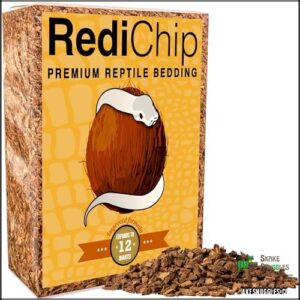
For ensuring your ball python stays comfy, RediChip Coconut Reptile Bedding is a solid pick.
It’s 100% organic, dust-free, and perfect for maintaining the right humidity—no soggy mess.
This medium coconut chip substrate holds moisture well but doesn’t overdo it, helping prevent shedding issues and scale rot.
Plus, it’s versatile! You can use it dry or moistened, depending on your setup.
With positive reviews on cleanliness and odor control, it checks all the right boxes for a safe, happy snake.
Best For: Owners of ball pythons and other reptiles who need a clean, versatile substrate that maintains proper humidity levels.
- Effectively holds moisture without oversaturation.
- Organic and dust-free for a cleaner enclosure.
- Helps prevent shedding issues and scale rot.
- May require additional mixing for larger enclosures.
- Mild reports of dustiness by some users.
- Regular maintenance needed to avoid bacterial buildup.
2. ReptiChip Premium Coconut Reptile Substrate
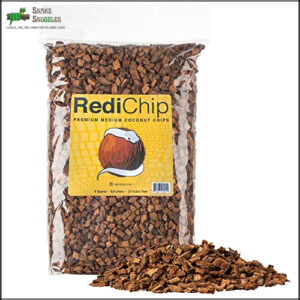
Ever wonder why so many snake owners rave about ReptiChip?
This premium coconut reptile substrate works wonders for keeping ball python habitats humid and cozy. It’s 100% organic, super absorbent, and expands into a heap of soft, moisture-holding bedding.
Plus, it’s odor-absorbing and low on dust, meaning less mess for you.
Sure, it might cost a bit upfront, but its durability and ease of use make it a solid investment.
Your snake will love it, and you’ll love the simplicity!
Best For: Reptile owners, especially those with ball pythons or tortoises, looking for a high-quality, humidity-retaining, and low-dust substrate.
- Organic and odor-absorbing.
- Excellent humidity retention.
- Low dust and easy to use.
- Higher upfront cost.
- May require occasional rehydration to maintain moisture.
- Some users report concerns with longevity.
3. Joshs Frogs BioBedding Tropical Substrate 10 Quarts
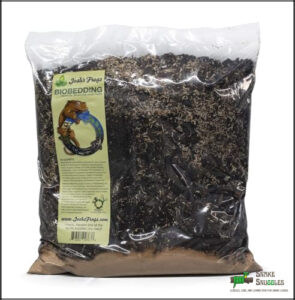
When you’re ready to level up your ball python’s habitat, Josh’s Frogs BioBedding Tropical Substrate is your go-to choice.
This all-in-one mix combines 80% soil with 20% play sand, topped with a cozy layer of leaf litter, it’s like creating a tiny slice of the wild right in your snake’s enclosure.
The 10-quart package gives you plenty to work with, and since it’s bioactive-ready, you can add cleanup crews like isopods and springtails.
Your snake will love the natural feel, and you’ll love how it maintains perfect humidity levels.
Best For: Ball Python owners and tropical reptile enthusiasts seeking a naturalistic, bioactive substrate that supports humidity and plant growth.
- Retains moisture well to maintain ideal humidity levels.
- Bioactive-ready, supports cleanup crews like isopods and springtails.
- Naturalistic design enhances the snake’s environment.
- Risk of introducing unwanted organisms (hitchhikers).
- Requires monitoring moisture levels to prevent mold issues.
- May need mixing with other substrates for optimal results.
4. Zoo Med Eco Earth Loose Coconut Fiber Reptile Substrate
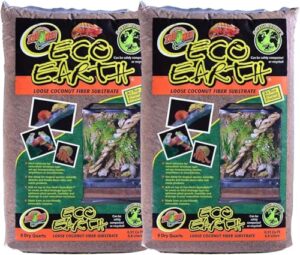
This coconut fiber substrate from Zoo Med feels like a cozy blanket for your ball python, keeping moisture locked in where it belongs.
You’ll love how it naturally absorbs and breaks down odors, making maintenance a breeze, and it’s easy to clean.
It comes damp and ready to use, though you might need to re-moisten it occasionally, making it a low maintenance option.
Perfect for tropical species, it’s completely safe for composting when you’re done, and it works great with drainage layers like HydroBalls to create the perfect humidity haven for your scaly friend.
Best For: Tropical reptile and amphibian species owners who want an easy-to-maintain substrate that supports humidity.
- Naturally retains moisture and boosts humidity.
- Absorbs odors and is compostable for eco-friendly disposal.
- Ready to use and compatible with drainage systems like HydroBalls.
- May dry out and require occasional re-moistening.
- Some reports of damaged or leaking packaging.
- Inconsistent packaging quantity reported by customers.
5. Zoo Med Forest Floor Bedding 2 Pack
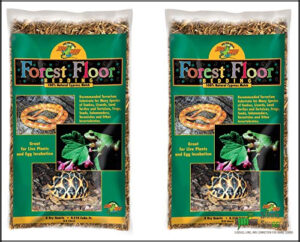
Zoo Med’s Forest Floor Bedding brings the natural feel of cypress mulch right to your python’s home.
This 2-pack delivers excellent moisture retention for maintaining those important humidity levels.
Your scaly friend will love the forest-floor texture, perfect for exploring and natural behaviors.
While it’s not the most eco-friendly option, and those larger pieces might be a bit much if swallowed, it’s a solid choice for humidity control.
Plus, it’s a breeze to clean and gives your terrarium that wild, natural look you’ve been after.
Best For: Ball python owners seeking a natural, moisture-retaining substrate to maintain proper humidity levels and encourage natural behaviors.
- Excellent moisture retention for sustained humidity control.
- Natural forest-floor appearance and texture.
- Easy to clean and manageable for regular maintenance.
- Not eco-friendly compared to some other substrates.
- Large mulch pieces might pose a risk if ingested.
- Smaller bag size may be insufficient for larger enclosures.
6. Joshs Frogs Bulk Aspen Reptile Bedding 48 Cubic Feet
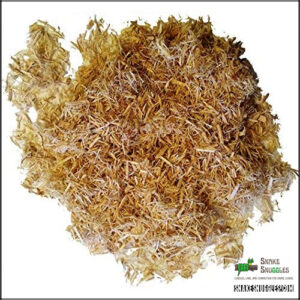
While aspen bedding offers excellent burrowing opportunities and odor control, it’s not your best choice for ball python humidity needs.
Josh’s Frogs Bulk Aspen comes in an economical 48 cubic feet size and boasts being dust-free and hypoallergenic.
However, there’s a catch – aspen doesn’t retain moisture well, making it tricky to maintain proper humidity levels. Plus, recent reports of mite issues after bedding changes raise concerns.
If you’re set on using it, you’ll need to work harder with regular misting and humidity management.
Best For: Reptile owners looking for a cost-effective, clean, and burrow-friendly bedding option for species not requiring high humidity.
- Economical size for large collections.
- Dust-free, hypoallergenic, and odorless.
- Encourages natural burrowing behavior.
- Poor moisture retention for humidity-dependent reptiles.
- Requires extra effort for humidity management.
- Reports of potential mite issues after bedding change.
Substrate Maintenance Tips
You won’t believe how much easier your ball python’s life becomes when you keep their substrate clean and fresh, just like changing your own bedsheets.
Whether you’re dealing with coconut husk or bioactive setups, you’ll need to know the right cleaning schedule and methods to keep your scaly friend’s home healthy and humidity-perfect.
Spot Cleaning Frequency
Like a diligent housekeeper, you’ll need to spot clean your ball python’s substrate daily.
Remove any waste, shed skin, or soiled areas promptly to maintain proper humidity levels and prevent bacterial growth.
Keep a close eye on areas around the water dish and hiding spots, where moisture tends to accumulate.
A quick daily check during your humidity monitoring routine keeps your snake’s home fresh and healthy.
Regular cleaning with a Python Substrate Cleaner is essential for maintaining a healthy environment.
It is also crucial to maintain the substrate in a way that supports the overall well-being of your pet.
Full Substrate Replacement Schedule
Depending on your ball python’s substrate choice, you’ll need different replacement schedules to maintain ideal humidity levels.
Replace non-bioactive substrates monthly, while bioactive setups can last 3-4 months before needing a refresh.
Keep substrate depth at 2-4 inches for proper moisture retention.
Your cleaning schedule might need adjusting based on your snake’s habits and the substrate’s moisture-holding capacity.
Sanitizing and Disposal Methods
Proper sanitizing and disposal methods keep your ball python’s home fresh and clean.
When it’s time for a full substrate replacement, here’s your game plan:
- Bake used substrate at 250°F for 30 minutes to eliminate harmful microbes and bacteria
- Store clean substrate in sealed containers to prevent mold growth
- Dispose of waste in biodegradable bags, following local guidelines for organic waste removal
Remember, regular cleaning prevents unwanted creepy-crawlies from crashing your snake’s party!
Humidity Management Tips
You’ll be amazed at how much easier it’s to keep your ball python’s humidity just right when you’ve got the perfect setup of heating, misting, and substrate working together.
With a few simple tweaks to your ventilation and the right moisture-loving substrate, you’ll have your snake’s home feeling like a cozy tropical paradise in no time.
Heating and Humidity Control
Now that you’ve got your substrate setup dialed in, let’s talk temperature – it’s the secret sauce for perfect ball python substrate humidity.
Proper humidity control is essential for a snake’s overall health and well-being, so consider reading more about snake terrarium humidity control.
You’ll want to maintain 88-92°F in the hot spot and 76-80°F on the cool side.
Heat mats work better than bulbs for this, and they won’t dry out your substrate as quickly.
Remember, stable temperatures help lock in that sweet spot of 50-60% humidity.
Mistening and Fogging Techniques
Three key techniques help maintain perfect ball python substrate humidity: misting, fogging, and strategic water placement.
You’ll want to mist your snake’s enclosure lightly each morning, focusing on the substrate and décor.
A quality fogger system with adjustable fog density works wonders for humidity control.
Pro tip: use filtered water in your mister and fogger to prevent mineral buildup and guarantee snake substrate humidity.
For ideal results, understanding reptile fogger systems is essential for maintaining the right humidity levels.
Ventilation and Absorbent Substrates
Managing your ball python’s ventilation and substrate is like finding the sweet spot between a sauna and a desert.
You’ll want to balance air flow with humidity control to keep your scaly friend comfortable.
Here’s what experienced keepers do:
- Cover up to 50% of ventilation holes with acrylic strips for precise humidity control
- Layer absorbent materials like coconut fiber 2-4 inches deep
- Position water bowls near heat sources to boost ambient moisture
- Create humidity pockets using damp sphagnum moss in strategic spots
Substrate Selection Criteria
You’ll want to pick a substrate that works with your budget and your ball python’s unique personality, just like choosing the perfect bed for yourself.
Your choice should match your experience level and your snake’s age, whether you’re a first-time owner looking for something simple or you’re ready to tackle a more advanced setup like a bioactive system.
Budget Considerations
When setting up your ball python’s home, smart budget choices don’t mean compromising on quality. You’ll want to balance initial costs with long-term value.
Here’s a breakdown of your substrate options:
| Substrate Type | Initial Cost | Monthly Upkeep |
|---|---|---|
| Coconut Husk | $20-30 | $5-10 |
| Bioactive Soil | $50-100 | $0-5 |
| Natural Soil | $10-15 | $8-12 |
| Sphagnum Moss | $15-25 | $3-8 |
Choosing the right ball python substrate is essential for maintaining ideal humidity levels. Remember, cheaper isn’t always cost-effective. Bioactive setups have higher upfront costs but save money long-term through reduced maintenance.
Snake Age and Preference
Your ball python’s age plays an important role in substrate selection.
Hatchlings thrive on finer substrates with excellent humidity control, while juveniles need slightly coarser bedding that’s safe for exploring.
Adult ball pythons often prefer deeper substrates for burrowing.
Watch your snake’s behavior – if they’re constantly trying to burrow or avoid certain areas, it’s time to adjust their bedding to match their natural instincts.
Owner Experience Level and Substrate Choice
When you’re new to ball python care, start with coconut husk substrate – it’s forgiving and easy to maintain.
As you gain experience, you might want to explore bioactive setups or custom substrate blends.
Don’t worry about making mistakes; many experienced keepers started with simple options.
Remember, it’s better to master basic substrate maintenance before diving into complex mixes that need more attention.
Frequently Asked Questions (FAQs)
How Often Should I Replace the Substrate for My Ball Python?
You’ll want to replace non-bioactive substrates about once a month, but spot clean daily.
For bioactive setups, a full change every three months works.
Think of it as giving your snake a fresh start!
How Do I Know Which Substrate is Best for My Ball Python?
Imagine your home at 50-60% humidity—comfort for your python.
Pick a substrate like coconut husk or sphagnum moss for moisture.
Consider burrowing habits, cleaning ease, and cost; it’s a balance, like Goldilocks’ bed!
Are There Any Substrates That Need to Be Avoided for Ball Pythons?
Skip aspen shavings or softwood like pine and cedar—they’re like kryptonite for your snake’s lungs, releasing harmful oils.
Also, avoid paper or reptile carpet since they’re lousy for holding moisture, leading to humidity struggles.
How Do I Know if My Ball Python is Comfortable in Its Substrate?
Look for signs like calm, relaxed behavior, smooth shedding, and normal feeding.
If your python burrows or explores happily, and humidity stays steady, you’re nailing it.
Stress means tweaking substrate, warmth, or humidity.
What is the best substrate for humidity snakes?
Coconut husk and cypress mulch are your best bets for keeping humidity just right for snakes.
They hold moisture well and are safe for ball pythons.
Bonus: they help with shedding too!
What substrate holds the most humidity?
If you’re chasing the gold standard for humidity, bioactive soil takes the crown.
It stores moisture like magic, keeps environments natural, and even supports burrowing.
Plus, no soggy mess—perfect for maintaining a healthy enclosure!
How can I keep my ball python cage humid?
Keep your ball python’s cage humid by misting daily, using absorbent substrates like coconut husk, adding damp sphagnum moss, and partially covering ventilation.
A shallow water bowl and a reliable hygrometer help too!
What kind of bedding should I use for ball python?
You’ll want bedding like coconut husk or cypress mulch to keep humidity levels just right.
They hold moisture well and help with shedding.
Avoid aspen or cedar—they dry things out and can harm your snake.
How does substrate impact ball python behavior?
The substrate affects your ball python’s comfort and natural behaviors.
A good choice lets them burrow, explore, or feel secure.
Improper substrates can stress them out, mess up shedding, or even cause health issues.
What signs indicate a poor substrate choice?
Around 70% of reptile illnesses trace back to improper care, including poor substrates.
Watch for flaky sheds, constant burrowing for comfort, or moldy smells—it’s like your python’s screaming, “Help, my setup’s a disaster!”
Conclusion
Don’t underestimate the power of the right substrate—it’s the key to keeping your ball python healthy and happy.
Coconut husk stands out as the best substrate for ball python humidity, holding moisture like a pro while staying fungus-free.
Whether you keep it simple or go for a bioactive setup, maintaining that perfect 50-60% humidity level is essential.
Pair your substrate choice with proper cleaning, a good hygrometer, and some misting, and your snake’s shedding will be smooth sailing!
- https://www.zenhabitats.com/blogs/reptile-care-sheets-resources/ball-python-complete-substrate-guide
- https://reptifiles.com/ball-python-care-guide/ball-python-substrate/
- https://www.reddit.com/r/ballpython/comments/r3kp02/best_substrate_for_ball_python/
- https://www.reptileforums.co.uk/threads/what%E2%80%99s-the-best-substrate-for-ball-pythons.1299236/
- https://www.sciencedirect.com/topics/engineering/mould-growth


